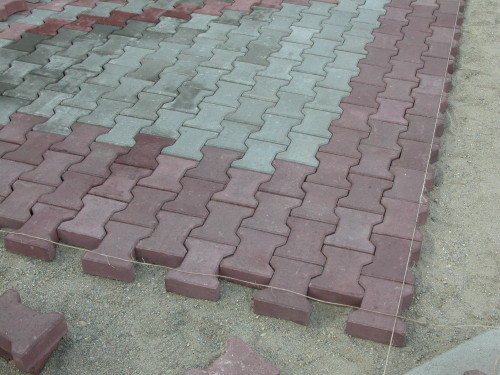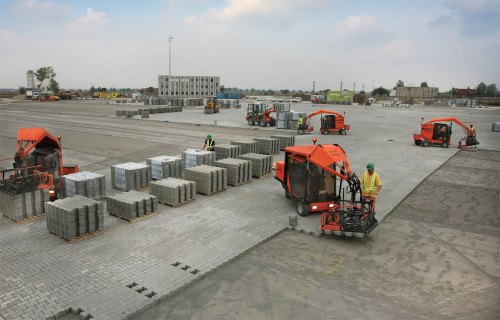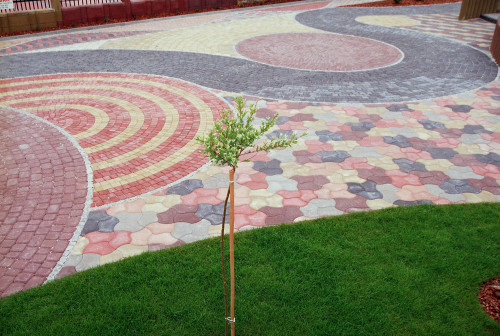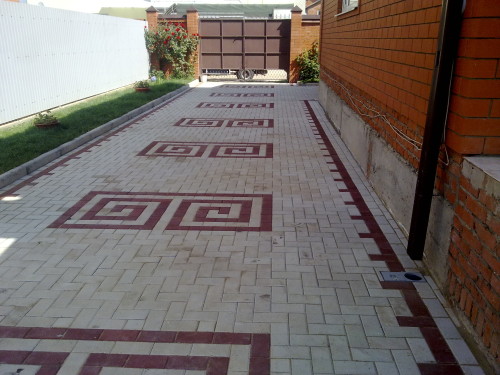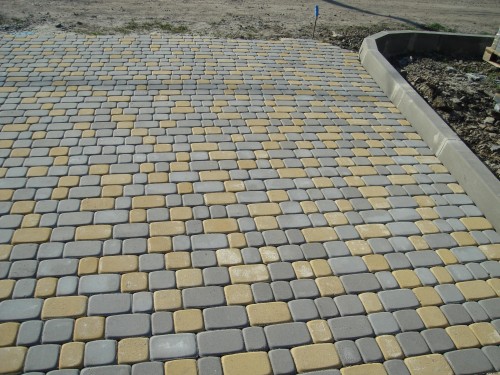Based on the paving slabs, pedestrian roads, garden sites and paths are created, and sometimes entire passage parts. Builders recognize that it is the pavement tile today is a kind of leader among materials to arrange surfaces on the streets. Obviously, such leadership got tile not just like that. The paving material has a range of positive parties that do not boast of dozens of other resources, including new products that applied the latest and practical developments in the building materials industry.
Content
Many people who plan to lay the paving slabs are often faced with difficulties. And this despite the fact that this process is almost the most elementary in construction. It is worth paying attention to the fact that today it is a lot of topical technologies that can be applied in certain cases for laying paving slabs.
Often, the laying of the tile is based on sand. This technology is inexpensive enough, and at the same time reliable. However, many are also interested in the technology associated with laying tile without sand. Accordingly, with this scenario, the basis for the material will be a solution that obviously will provide high surface quality.
In this material, we will consider the main features associated with the creation of a surface of paving slabs, which was laid on the basis of cement mortar. As already mentioned, the tile laying technology is quite simple, but at the same time there are many small details that can significantly affect the final result. It is also necessary to analyze the positive aspects of paving slabs.
Features of paving slabs
The paving slabs during the arrangement of various surfaces is used for many years. It is worth admitting that during this time the material has almost changed in any way. On sale only appeared various dyes and original forms that allow you to create a truly attractive platform or road. Immediately properties and other features The material remains in the previous positions. Despite such an ambiguous situation, singular competitors at the paving slabs simply not. As we have said, new materials appear regularly on sale, but they are not able to significantly reduce the popularity of paving material.
The same versatility of the paving slabs, which many builders and experts speak, and is the main power of the material. For example, a tile can be covered with a huge sidewalk near the roadway, or the highway itself. Sades put the tile directly to their sections - around the houses, as well as to create small paths between the sectors or sectors of the site. Accordingly, in all these cases, one material is used, one technology, all the same approaches and other subtleties of the process. If you consider other materials that are also used to create coatings, then such universality will not be able to boast such universality.
The most interesting thing is that, as we said, the paving slabs practically does not change for long years. From the very beginning, the material laying technology turned out to be almost ideal for most conditions in which the tiles are actively used. However, this does not mean that this resource is devoid of flaws. Unfortunately, the negative sides of this material is abused, and in some situations they have a tremendous impact on this or that situation. However, most often the positive aspects of paving slabs with ease overlap all the flaws.
In more detail, the advantages and disadvantages of paving slabs, we will look at the following in this material, but I would like to note in advance that the important advantage of the material is cheapness. Thanks to this tile, even those owners who have too modest monetary budget can be purchased. But at the same time should not think that with the relative cheapness, the paving slabs will not be able to boast of attractiveness. Practice shows that the material allows you to successfully decorate the plot, as well as emphasize the originality of the common style.
I would also like to note that there are not always the newest materials that go on sale are distinguished by high quality and other positive parties. Against the background of these most materials for surfaces, the paving slabs looks more than worthy. This once again confirms the statement that the new is not always the best. Accordingly, it is necessary to qualitatively analyze all the information associated with the choice of material to arrange surfaces, and only after that make some conclusions. No less important is the overall analysis of the situation associated with the site. In certain situations, the paving slabs is distinguished by some significant disadvantages. For example, it may be a large weight of the material on not the most reliable soil.
Paving tile - advantages and disadvantages
As we have already spoken, many people who plan to acquire paving slabs, first of all, pay attention to the main advantages of the material. This situation is more than erroneous, since ultimately the shortcomings can be too many problems.
Advantages:
- Price. We talked about this with several lines earlier. Practice shows that paving slabs is the perfect material in terms of price and quality ratio. This situation suggests that today the best material for surfaces has not yet been released than the pavement tile. The favorable price for the paving slabs means that it is quite possible to purchase more of this material than more expensive. Accordingly, you can cover a large area, and get the expected result. In some cases, savings allows you to spend money on some other materials to arrange a plot or territory. In today's conditions, even a small benefit is extremely important.
- Appearance. On the streets you can detect various surfaces from paving slabs, but almost all of them have a sufficiently modest style. Surely this is done in order to ensure the simplicity of perception of space. However, in fact, the paving slabs can be in the spotlight. Using some specific forms for tiles, as well as dyes, tile with ease will be attractive externally. It is also important to note that such details related to the creation of the original tile style still do not mean that the material will be more expensive. No difference in the production of classic and unusual tiles simply not.
- Production technology. Surely, many have heard that the sidewall tiles are often produced in handicraft conditions. We are talking about production not on a specialized enterprise, but, for example, in some garage. Ultimately, it turns out that the most limited conditions are quite enough to produce high-quality tiles, while forgetting about inconveniences and other negative sides of handicrafts. It also suggests that if desired, almost any owner can do the production of paving slabs. This requires only some equipment, as well as attentiveness and study technology.
- Practicality. The process of laying the tile, whether it is a sandy base, or cement, turns out to be sufficiently simple. However, this does not mean that to allow no errors to certainly fail. Tell technology. It is extremely simple, but has some details, without which the high-quality surface is hardly obtained. At the same time, the process of laying the tile is needed in a company of two or more people, as such events are alone - it is too long, and you can also easily be mistaken. The practicality of this process consists also in the fact that there are no need for too many equipment and devices to fully organize the process of production and laying the material.
- Durability. Of course, the paving slabs will not please their original appearance dozens of years, but the material has a certain margin of strength still has. This material (if the production technology is observed) is characterized by low surface abrasion. In addition, the frost resistance of the material is always at the height. With moderate operation, the sidewalk tile will delight with its reliability at least 10 years. Surely many paid attention to that many roads that are covered with sidewalk, approximately after 10-15 years of operation begin to gradually crumble. This is due to the association of several factors at once, gradually destroying the material. It is worth understanding that the mixture from which the tiles are made are not an eternal option. So that the track served hundreds of years should be closed, for example, to granite. However, this is too expensive.
Disadvantages:
- Slipping surface. Winter period is far from the best for surface tile surfaces. The situation is in such a way that even with small frosts the road becomes too slippery. Therefore, it is simply necessary to cover the surface with sand or salt so that the movement on such a surface is safe. It should be understood that many other materials also have this disadvantage, so the pavement tile in this situation does not stand out.
- Sailing. If we are talking about laying the tile, it is often a problem with uneven sizing material. Often this happens for the reason that the people who conducted the laying process violated technology. At the same time there are situations associated with the specifics of the soil. Some failures may well take place, and at the same time sorting tiles will be formed. To avoid similar troubles, it is necessary to carefully examine the ground for the presence of various disadvantages, due to which sending can occur.
- Use on passage parts. Many mistakenly believe that the universality of paving slabs allows the use of material in a wide variety of conditions. Practice shows that today this resource is not the best solution for covering the passage parts for cars. The situation is in such a way that a fairly fast surface will begin to see, and the tile is to deteriorate (collapse, lean abrasion). This is especially bad if trucks will move on a particular road. There are situations where the owners decide to lay tiles near their country house where there are practically no car movements (only neighboring cars are passing). With this situation, the road is quite capable of listening for a long time. In addition, an attractive appearance of such a road is an extremely important advantage.
Production of paving slabs
Before switching directly to the laying technology of paving slabs, the specificity of the material production should be considered. As we said, it is quite possible to produce this material in limited conditions. It is important to note in advance that your own production is better to organize only if large volumes of tiles are needed for certain works. Otherwise, it is better to immediately buy a tile of a particular seller.
First of all, we will need the containers in which components will be placed for a future mixture, as well as a concrete mixer.
We will need the following materials:
- sand;
- plasticizer;
- cement;
- crushed stone;
- water.
For a 3 cubic meter concrete mixer, 9 buckets of rubble, 6 buckets of sand, 250 ml of plasticizer, 50 kg of cement, as well as the required amount of water, so that the mixture has received the desired consistency.
The situation is also the situation in such a way that in some cases the corresponding dyes are used. It is worth noting that the dye volumes often depend on who released a particular product, so after purchase, you should pay attention to the information that goes along with the dye.
After carefully kneading the mixture in the concrete mixer (within a few minutes), you can move directly to the fill of the material in the mold. As for the forms, today the choice of this product is simply colossal. It is also necessary to pay attention to the fact that it is best to acquire plastic forms that can be used at least several times. As for the shape of the tile, which will be at the very end, then the Internet here should be used and find photos of ready-made surfaces covered with this tile. In most situations, the most simple variations of the tile look most interestingly, but minimalistly, which is often not accounted for to the owners.
When filled with each shape, it is necessary to understand that inside emptiness will definitely form, negatively affecting the quality of the material. Accordingly, here you have to contact vibration equipment.
As the very vibration equipment, you need to use vibrationtole (in handicraft) or vibrationboard (under production conditions). It is worth noting that not everyone has similar devices, so it makes sense to rent an installation from acquaintances or in building stores. Vibrotol is a smooth surface that the vibration is reduced below with debanel. Accordingly, even if after filling the mixture into the form there will be emptiness there, they quickly disappear, and the future tile will be distinguished by high density and excellent quality.
In order to quickly release the desired tile volume, a lot of forms will be required. Print vibrations Every individual form is needed within 30-40 seconds. Further, the form goes to a place protected from precipitation and sharp temperature drops. The material must be a little sequished so that during use it differs high quality. Often for a sufficient set of strength paving slabs takes several days. However, it is necessary to remember that concrete gains strength during a couple of weeks, so a certain time after laying the material you need to somewhat limit the operation of the surface.
If there are too few forms in stock, then it is obvious that the handling process of the material production will move long enough. However, if the volumes of the tiles are needed not too large, then the situation is quite acceptable.
Laying paving slabs
As you know, laying of paving slabs often occurs on the basis of sand. In this case, it turns out a fairly high-quality surface that will delight the owners for long years.
However, it happens that people refuse to use sand in this process. It can be specific technology, or easy money saving. Practice shows that the refusal of sand in some situations really takes place. First of all, it is worth paying attention to the fact that instead of sand, a cement solution can be used, which will fill all the emptiness between the tiles and create a practically monolithic surface. Next, we consider the basic details of the above solutions.
Materials and marking of the territory
For the laying process of paving slabs, the following materials and devices will be required:
- building level;
- rubber cizyanka;
- master OK;
- metal pegs;
- rake;
- watering hose.
Other materials may also be required, which may simply be needed in certain conditions.
Marking is an extremely important process that allows you to accurately understand exactly where the framework of the road or platform should be located. It is necessary to understand the fact that at first glance, the existing territory can be an ideal base for laying the tile, however, in the process, some problem areas that create serious trouble can be detected. Accordingly, you need to arm the metal splies, which are located in the corners of the track (or playgrounds), and the thread, it must be tightened between the carriages so that there is a peculiar markup. This solution will allow fully inspecting the territory and understand how the track will be located. During such a visual inspection, it is possible to detect, for example, various stones, failures and other shortcomings of the surface that may affect future work. Accordingly, you should do everything possible to minimize possible problems on the site.
Also, the markup will allow you to set the dimensions of the future plot for laying the tile, and this allows you to read the desired volumes of the material.
Creating a surface
- First of all, the basis is created on which most of the success of the work depends. It is necessary to remove some soil layer to make the basis most stable and reliable. It is worth it in mind that the future platform (or track) should have a small slope. This can be just a pair of degrees, however, this is enough so that the sediments go beyond the surface.
- If we are talking about creating the base from sand, then the layer is 20-30 cm. In the event that the sand is not applied, then the layer being removed should be smaller. Immediately you need to think about the Communications laying. It is best to deal with this at this stage.
- The next stage traditionally consists in creating a pillow of sand and rubble. In our case, the laying will occur directly to the ground. In addition, it is possible to lay a tile on fine crushed stone, or a cement solution (cement-sand mixture in a 3: 1 proportion). At the same time, it is important to use borders that will be a certain frame for the future surface. Borders deepen into the soil at sufficient depth, after which the laying of tiles occurs. If the crushed stone is used as a pillow, or the solution is simply poured, you need to remember the leveling, otherwise the surface will be far from the most practical.
- The laying of the tile comes from itself, and if only the base of the soil is used, it is advisable to make the distance between the tiles minimal, since otherwise the tile will actively move and disrupt the condition of the surface. Already after laying the seams, it is still possible to fill with sand so that the surface differs sufficient to operate density.

